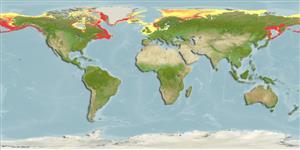Preferred temperature (Ref.
123201): 0.2 - 7, mean 2.3 °C (based on 1058 cells).
Phylogenetic diversity index (Ref.
82804): PD
50 = 1.0000 [Uniqueness, from 0.5 = low to 2.0 = high].
Bayesian length-weight: a=0.00355 (0.00148 - 0.00852), b=2.95 (2.74 - 3.16), in cm total length, based on LWR estimates for this (Sub)family-body shape (Ref.
93245).
Nível Trófico (Ref.
69278): 3.3 ±0.39 se; based on food items.
Generation time: 11.1 ( na - na) years. Estimated as median ln(3)/K based on 2
growth studies.
Resiliência (Ref.
120179): Baixo, tempo mínimo de duplicação da população 4,5 - 14 anos (tm=7; tmax=12; K=0.099; Fec=931).
Fishing Vulnerability (Ref.
59153): High vulnerability (59 of 100).
Nutrients (Ref.
124155): Calcium = 22.3 [4.8, 93.2] mg/100g; Iron = 0.512 [0.172, 1.359] mg/100g; Protein = 16.8 [14.9, 18.9] %; Omega3 = 0.288 [0.112, 0.751] g/100g; Selenium = 9.62 [3.01, 35.80] μg/100g; VitaminA = 35.4 [6.5, 194.5] μg/100g; Zinc = 0.57 [0.29, 1.21] mg/100g (wet weight);
